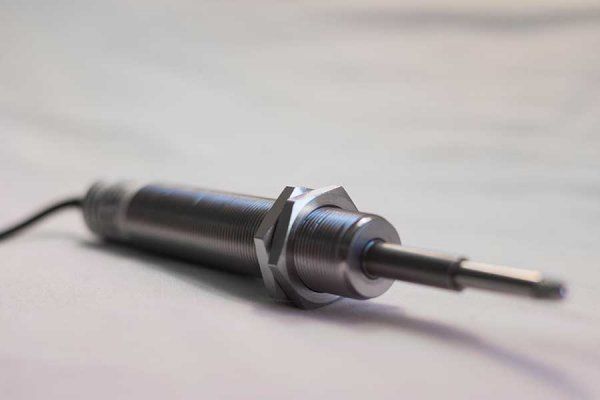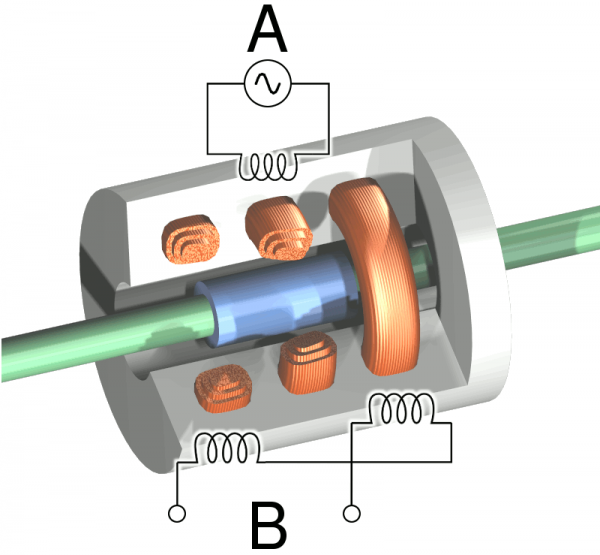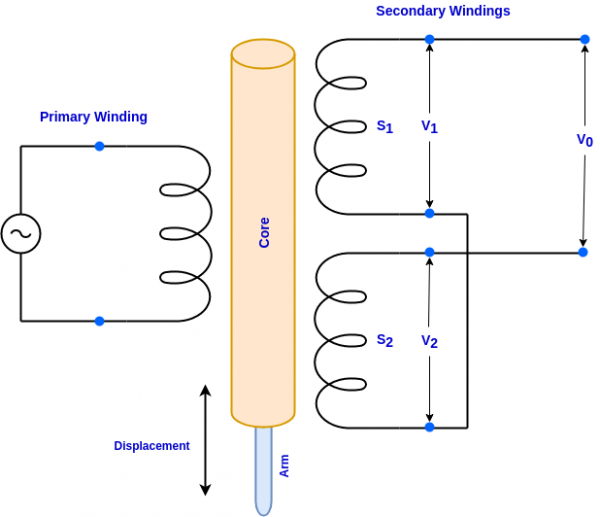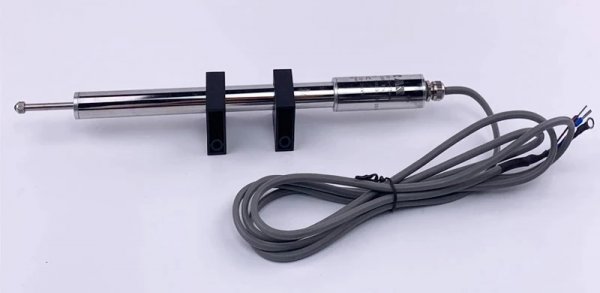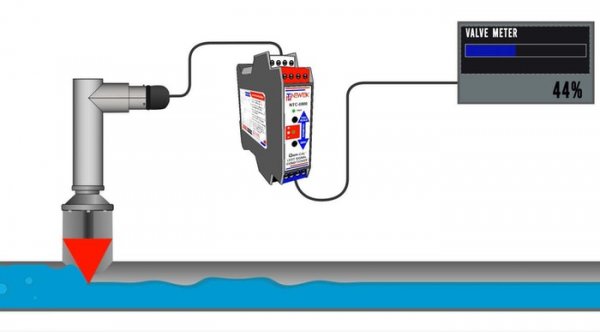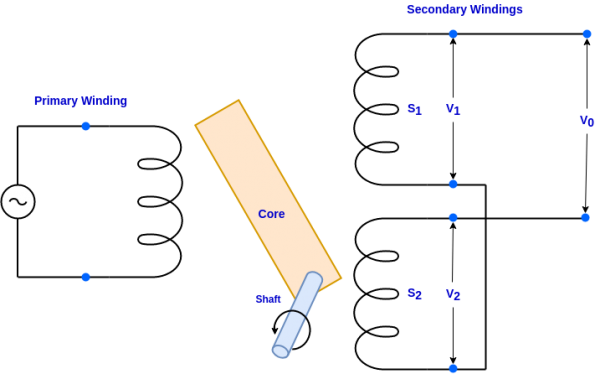What is a linear differential transformer
An alternating current flowing in one primary coil can be used to induce an alternating voltage in two secondary coils. If the two secondary windings are identical in their characteristics and the two paths of the magnetic field lines passing through these coils are also identical, then the two secondary voltages generated will be equal. A device with this structure is called a differential transformer.
A differential transformer can have an air core or a magnetic core.
Two secondary windings can be connected either in phase or anti-phase, in the first case their voltages are added to each other and in the second case one is subtracted from the other.
A primary winding is used to drive two symmetrical secondary windings, the latter of which can be connected so that the secondary voltages add to or subtract from each other.
If two coils are connected according to a subtraction scheme, then at the same values of their voltages, the total secondary voltage will be zero.If the magnetic circuit characteristics of one of these coils are intentionally altered compared to the magnetic circuit characteristics of the other coil, then the two secondary voltages will differ and their difference will not be zero.
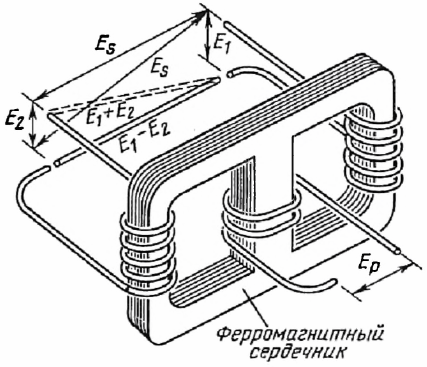
Under these conditions, the phase of the total secondary voltage indicates which path of the magnetic field lines has the greatest resistance, while the amplitude of this voltage reflects the value of the reluctance difference.
If the same action is used to increase the magnetic resistance of one path and to decrease the magnetic resistance of the other path, then the output voltage reflecting this action reaches its maximum value, and the transfer function will have the greatest possible linearity.
Since no two secondary windings and no two paths of magnetic field lines can be made exactly the same, a differential transformer always has a definite output voltage, even with zero useful signal at the input.
In addition, the characteristics of magnetic circuits are non-linear. As a result of this non-linearity, even harmonic components of the fundamental frequency of the applied primary excitation voltage appear, which cannot be fully compensated for in any arrangement of the secondary windings.
The reluctance of an air-gap ferromagnetic circuit is a function of the gap width with strong nonlinearity. As a result, the inductance of a coil wound around such a circuit is also a non-linear function of the gap width.
At the same time, if there are two more or less identical paths of the magnetic field lines, each with an air gap, and if the width of one gap increases as the width of the other decreases, then the difference in magnetic resistance of these paths can vary sufficiently linearly.
The basic principles of the differential transformer are embodied in practice in a variety of specific design configurations for many different purposes.
Linear Variable Differential Transformer (LVDT) is a passive transducer (sensor) that works on the principle of mutual induction and can be used to measure displacement, strain, pressure and weight.
Most often they using NS can be used to measure displacement in the range of several millimeters to centimeters, directly converting I'm displacement into an electrical signal.
The inductance of the coil near or inside which the ferromagnetic rod is located is a function of the coordinate of the position of this rod relative to the coil with strong nonlinearity.
If such a rod is a ferromagnetic circuit of some differential transformer, then the secondary differential voltage can serve as an indicator of the displacement of the rod, depending linearly enough on this displacement.
The primary winding is connected to an AC source. The two secondary windings S1 and S2 have an equal number of turns and are mounted in series opposite each other.
Thus the EMF induced in these windings is 180° out of phase with each other and thus the overall effect cancels out.
The position of the symmetrical ferromagnetic core provided in the design of the differential transformer can be determined from the phase and amplitude of the secondary voltage.
The absolute difference between the two secondary voltages indicates the absolute value of the displacement of the rod relative to the center or zero position, and the phase of this different voltage indicates the direction of the displacement.
The B / I curve of a linear variable differential transformer is shown in the figure.
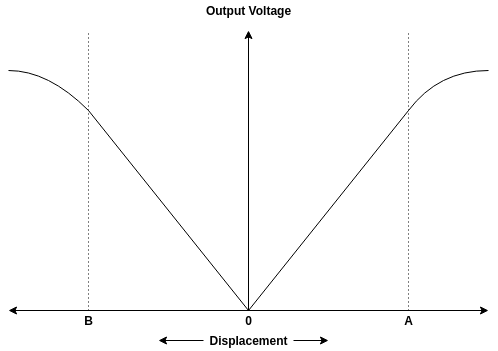
An example of using a linear differential transformer to provide accurate position feedback for valve monitoring and control in chemical plants, power plants and agricultural equipment:
Submersible displacement sensors LVDT D5W:
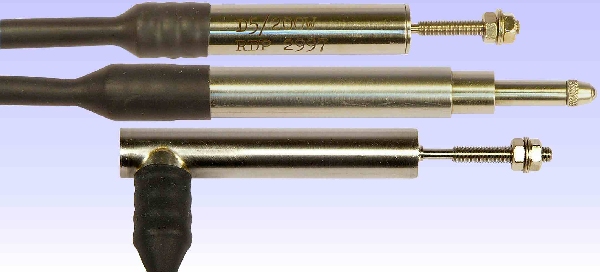
These transducers are designed to measure displacement and position. They provide accurate measurement of the position of the armature (sliding part) relative to the displacement sensor housing.
Submersible displacement transducers are designed to take measurements while immersed in suitable liquids. Non-magnetic liquids can flood the armature tube without affecting the operation of the converter. These converters are available in uncontrolled or spring return versions.
When automating various technological processes, bilateral converters with a differential transformer with a ferromagnetic core, which is inserted at its ends at equal distances into the two secondary coils, are often used.
As the rod moves axially, it moves deeper into one of these coils and extends from the other.The absolute difference between the two secondary voltages indicates the absolute value of the displacement of the rod relative to the center or zero position, and the phase of this different voltage indicates the direction of the displacement.
Rotary AC Differential Transformer:
A rotary variable differential transformer is a passive transformer based on the principle of mutual induction. It is used to measure angular displacement.
Its design is similar to that of a linear variable differential transformer except for the core construction.
The primary winding is connected to an AC source. The two secondary windings S1 and S2 have an equal number of turns and are mounted in series opposite each other.
Advantages of linear differential transformer:
-
There is no physical contact between the core and the coils;
- High reliability;
-
Quick response;
-
Long service life.
It is the most widely used inductive sensor due to its high accuracy.

